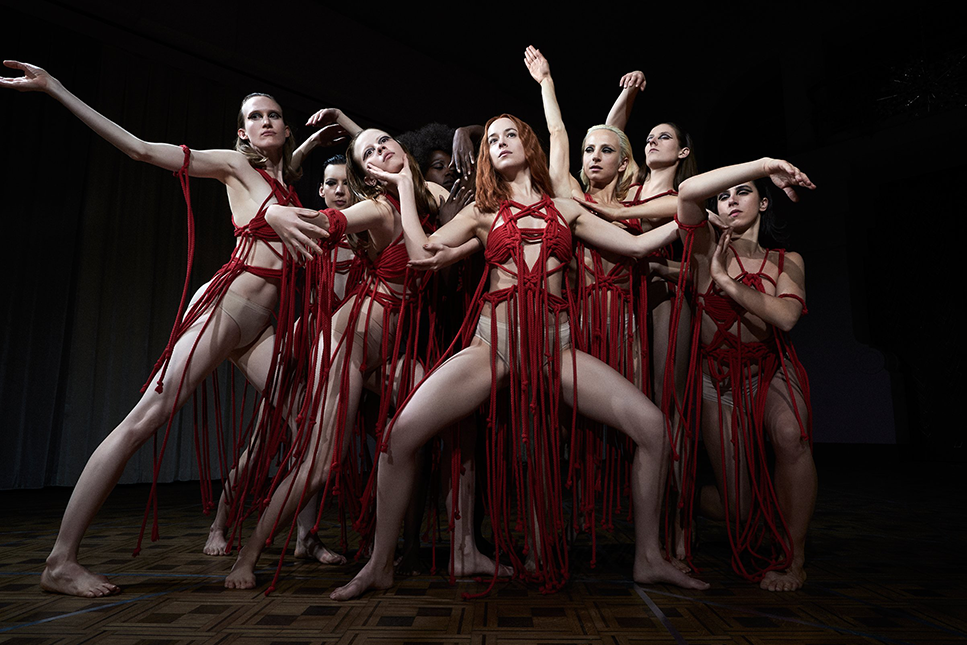 I’ve long been a fan of Dario Argento’s 1977 horror flick Suspiria, and I’m certainly not alone. Among horror film aficionados, Suspiria is revered as much for its memorable cinematography and score as its ability to remain compelling despite having an almost nonsensical plot. So when the news came that a remake of this seminal Italian film was in the works, the natural question was, “Why?”
I’ve long been a fan of Dario Argento’s 1977 horror flick Suspiria, and I’m certainly not alone. Among horror film aficionados, Suspiria is revered as much for its memorable cinematography and score as its ability to remain compelling despite having an almost nonsensical plot. So when the news came that a remake of this seminal Italian film was in the works, the natural question was, “Why?”
Remakes are the subject of perennial debate among movie buffs. Very occasionally a remake will be superior to the original (John Carpenter’s The Thing is the canonical example among horror fans) but usually we’re left wondering why Hollywood couldn’t just come up with an original idea. Double down on that when the film being remade is one like Suspiria, where it’s so inventive, so original, yet even its author seems utterly incapable of understanding why it is so beloved. Take a look at Argento’s later output, including the mediocre Mother of Tears (supposedly the capper of a trilogy that began with Suspiria) and the risible Dracula 3D, and the kooky and confusing Suspiria starts to look like a holy relic unearthed from an Egyptian tomb.
In reality, the 1977 Suspiria is hardly that. But having now seen the 2018 remake, I have to wonder whether the studio and the filmmakers, much like characters from a dusty old mummy movie, weren’t evoking powers that they didn’t understand. Or maybe that was just me. Maybe I was the one who didn’t get it.

The same, yet different
The original’s premise is simple enough. A dance student, Suzy Bannion, enrolls in a dance school in Freiburg, Germany. It transpires that the school is a front for a coven of witches, headed by the mysterious Helena Markos. Murders and other ghastly events transpire. Eventually Suzy uncovers the secret, confronts Markos, and in true horror-movie form, the school ends up burned to the ground.
In true modern remake form, the 2018 version of Suspiria keeps much of this structure yet tries to turn certain aspects on its head. For example, most of the character names are the same – Suzy Bannion becomes Susie Bannion – but key themes are replaced, outcomes happen the opposite way from the original, and plot points are replaced in favor of new ideas. None of this is bad, per se. But it needs to justify itself. Why are we watching this movie instead of the original?
Another thing that’s been swapped out is the cinematography style. The 1977 Suspiria is known for its inventive lighting, with scenes awash in surreal primary colors, almost like a comic book or a Halloween funhouse. The remake discards this in favor of a more naturalistic look, but it still tries to evoke unease in the viewer with odd, unnecessary camera movements. Sometimes this works, and sometimes it just advertises that someone is trying to be clever.
The band Goblin’s score for Argento’s Suspiria is legendary for its discordant, 70s-groovy sound. The remake uses a score by Radiohead’s Thom Yorke, and while it meshes with the visuals well enough, it is nowhere near as memorable or interesting. Yorke’s credit just comes off as a novelty, another way to sell the film.
Another thing Argento’s Suspiria is known for is its over-the-top gore. This was typical of Italian directors of the era, including Argento but also Lucio Fulci, Lamberto Bava, Umberto Lenzi, Bruno Mattei, and others. In hindsight, Argento’s blood in Suspiria looks like tempura paint and it’s hard to imagine why anyone would need to go to such elaborate lengths to murder someone. But that’s all part of the fun.
Conversely, the 2018 Suspiria makes some overtures to this type of death-count filmmaking, but for some reason its gore scenes aren’t as effective as Argento’s. An early scene where an evil spell uses a dance to play origami with a woman’s body, snapping and twisting her limbs, is novel and a top-notch example of modern CG effects, yet it isn’t particularly moving. We don’t know who this character is. Should we care? The film’s naturalistic style, combined with its omniscient-narrator point of view, work against it here. We witness some bad stuff happening. What are we, the audience, to make of this?
Go home, Suspiria, you’re drunk
And herein lies the problem with Suspiria 2018. They changed a bunch of things intentionally and they added a bunch of things, to the extent that there’s so much stuff in this movie that I feel like audiences – whether they’ve seen the original or not – are going to be left scratching their heads.
Even the basics seem a little elusive. So: Witches. Good? Bad? Bad, I’m guessing, but as long as they’re content to hang out in a dance school in a minor city in Germany I guess I’m OK with it. What’s their ultimate goal? They seemed to want to fulfill some sort of prophecy, but I can’t say I glommed what it was.
And then there are the themes. Themes, themes, themes. The new film is set in 1977 – the year Argento’s film was released – and incorporates events that were happening in Germany that year, the year of the so-called German Autumn. These included the kidnapping and murders of prominent public figures and a notable aircraft hijacking. The Baader-Meinhof Group, a militant faction active in Germany at the time, is mentioned multiple times. Another character is haunted by events of the Holocaust. The camera keeps returning to images of the Berlin Wall. Meanwhile, Susie Bannion is said to have had a Mennonite upbringing – even though this doesn’t make much sense, since we’re later told she’s not who she seems to be.
The question is, what does any of this have to do with a horror flick about witches and black magic? Unfortunately, Suspiria 2018 offers no answers. I found myself exchanging confused glances with my fellow cinemagoers many times. All this stuff just comes off as hand-waving, like a filmmaker who is desperate to add gravitas to a rote remake job that’s essentially just schlock. “What does it mean? That’s up to yyoooouuuuuuu to decide!”
Maybe I missed some things. Maybe some finer plot points eluded me. If so, I chalk that up to the movie’s bloated run time. At 2 hours and 32 minutes, it starts wearing out its welcome well before the midpoint. It doesn’t help that it announces that its story is divided into six “Acts” and offers cue cards introducing each one, prompting the audience to mutter under its breath, “Oh Christ, we’re only on Act Three?”
Anything good?
Unlike some folks I’ve spoken to, I didn’t hate the movie. Tilda Swinton deserves special mention. I enjoy her in almost everything she’s in. As Madame Blanc, the lead choreographer of the school, she’s mostly doing her Ice Queen bit, but she succeeds in bringing a subtle layer of barely-restrained emotion to the role that makes her probably the most compelling character in the film.
Famously, however, Madame Blanc isn’t Swinton’s only role. Under layers of makeup, she also plays Helena Markos, the head of the coven. In Argento’s film, when Markos wasn’t invisible, she looked like a cartoon crone covered with oatmeal. Here she’s an obese, ancient woman wearing blackout sunglasses, a transformation that renders Swinton unrecognizable. Perhaps even more remarkable, though, is Swinton’s turn as Dr. Josef Klemperer, a psychiatrist who is investigating events at the dance school. For a while, Swinton and director Luca Guadagnino pretended that Klemperer was played by first-time actor “Lutz Ebersdorf,” but they have since come clean that the role is indeed Swinton in another product of the makeup department.
These makeovers are certainly convincing. Yet again, one has to ask what is the point? Was Swinton cast in three roles to save money? Was it to create buzz for the film? My own belief is that it was done so Guadagnino could say that, other than two police officers, his film had an entirely female cast. But this is just more winking and nodding at the audience. That fact might make the film unusual, but what do we gain from the knowledge?
And that’s my ultimate take on Suspiria 2018. It’s not a terrible take on the subject matter. It’s just not clear what the filmmakers’ purpose was in remaking it. It feels like a trashy horror movie with a generous helping of literary pretensions ladled on top of it.
Die-hard Suspiria 1977 fans will doubtless want to see it, whether that’s just out of curiosity or to confirm their suspicions that it’s unworthy crap. But fan or otherwise, I suspect very few people will give Suspiria 2018 the repeat watchings necessary to come up with even a theory of what it’s about. Why spend the time questioning it, when the answers just don’t seem all that important, if they exist at all.

Excellently written!